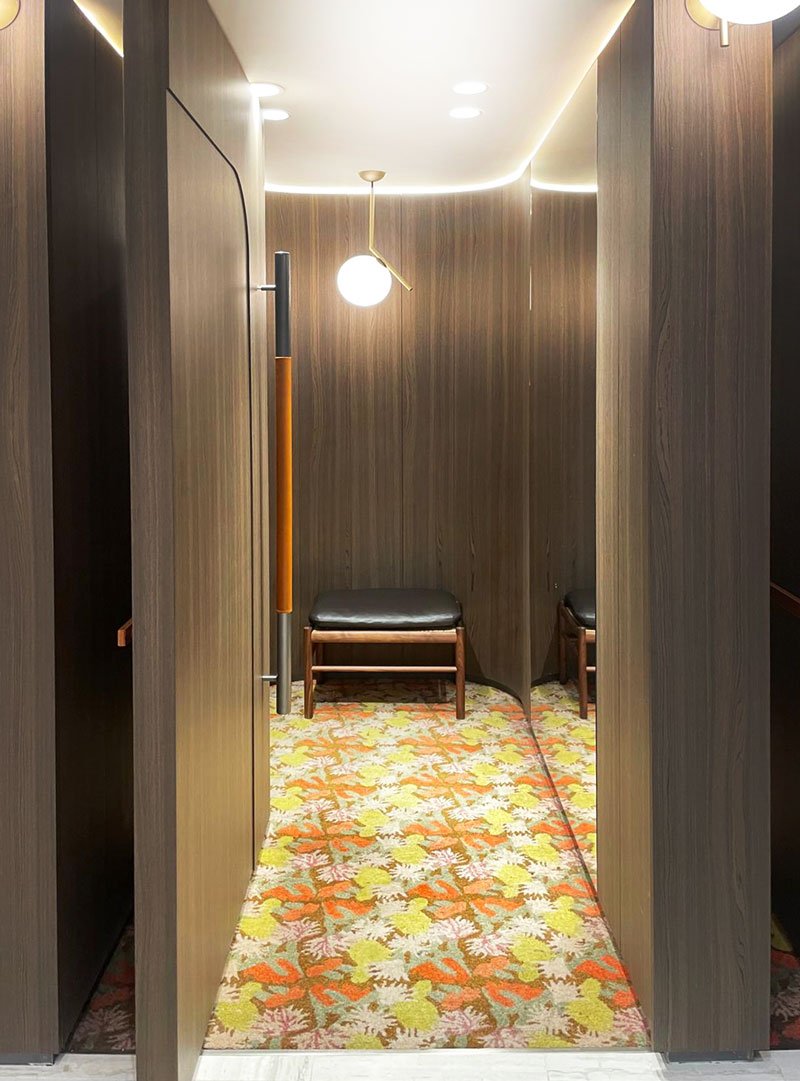INSIGHT
New York State of Mind: Escapism, Connection & Craft in the City
A recent snowy weekend trip to NYC involved a stay at The Public, and a number of fashion and lifestyle openings.
It made us reflect on some of the trends highlighted in the recent VML , The Future 100 2025 report.
As part of a broad overview, one of the considerations that the report focused on was that in an unsettling world, the desire for escapism, a more ‘soothing’ reality, with a sense of ‘imaginative optimism’ is more compelling than ever.
The report also referenced the quest for respite from a fast-paced world in a yearning for ‘analogue moments’ and tactile activities, where brands have much to gain by engaging all of the senses.
Linked to the increased focus on AI, is a corresponding cherishing of things made by the human hand and the comfort we derive from objects that have human craft and creativity at their heart.
One of the most resonant highlights was on the craving for connection, and sense of belonging and how brands can facilitate this and simultaneously build a sense of brand community.
The Public Hotel
This consideration is one that Ian Schrager’s Public Hotel amplifies. With vast, and mixed social and dwell spaces, to meet every mood, there was a genuine sense of community, and mix of individuals to deliver his vision of ‘luxury for all’.
Dynamic social spaces in Public Hotel, NYC
Many of the stores we visited were more like an expression of a personal vision, well crafted and furnished, rather than shopfitted and predictable.
These brands appear to have consciously created spaces that encourage more of a sense of slowing down, of dwelling, relishing the power of the pause, taking a moment to immerse oneself in the physical environment, and take joy in the sounds, scents, tactility, and be enchanted by a space where pieces feel chosen, and carefully considered.
These environments also felt like a response to providing more social spaces. One recurring feature was the creation of lounge spaces within the stores, and also, significantly spaces in and around the fitting rooms to encourage dwell, and engagement and interaction not only with the store teams but also other customers.
Sezane, NYC
Sezanne cleverly amped up its Paris based origins, with the lovely local touch of the Bonjour New York signage, and welcoming cookies, whilst retaining it’s ‘apartment store’ concept.
Poetry
For this British brand, Poetry first just opened NYC store, the emphasis was on a ‘slow’, immersive space, beautifully mirroring their sustainable ethos. The furniture and interiors felt considered, carefully selected which resulted in a sense of a personal, intimate space, where the product felt elevated and special. It also had a gently, and subtlety expressed Britishness, proving that there are more inventive ways to express British origins than the sometimes cliched options.
Buck Mason
Buck Mason, had a strong, singular aesthetic, with its charm residing in the way it felt put together in an effortless, uncontrived way, simple, but very effective and distinctive. A Californian tightly edited lifestyle store, created by founders Sasha Koehn and Erik Allen Ford in 2013, offering timeless, modern American classics. Even in these small spaces, seating and hospitality elements created a relaxed atmosphere that felt as it was the perfect meeting space for brand fans. A mix of quirky independents in Chelsea, Bleecker Street including another branch of Buck Mason, with their recognisable signature brand aesthetic, but beautifully adapted to the individual style.
Loeffler Randall
This flagship store was a lovely discovery, a highly feminine blend of footwear and fashion. The Loeffler Randall stores are focused around styling, and personal appointments, almost like a salon space. The space beautifully mirrors the distinctive, aesthetic of the brand, crafted, and a perfect backdrop for their signature hand tied bow shoes. The founders boast a loyal clientele amongst brand fans that identify with this singular point of view, and the sheer specialness of a product which has had 60 pairs of hands touch each product from sketch to finished product, truly a brand with the human touch at its heart.
Cuyana
Cuyana, a San Francisco brand based around ‘fewer better things’ by Karla Gallardo and Shilpa Shah, has built its success around rather than hero products, items that provide ‘women’s premium essentials’. Starting with their signature tote bag, with customisable add ons, to allow each customer to create their own individual system, (from clutter to clarity) the business then developed a (covid inspired) loungewear collection, and now a small, tightly edited fashion collection. The founders regard their stores as offering the instant gratification of retail with the intimacy and personalisation of an atelier. The personalisation service created a sense of theatre and point of interaction. The interiors from exterior to interior, with its clean lines, and simple, pared back merchandising beautifully mirrored its clutter to clarity ethos.
Bottega Veneta
Appreciating that Bottega Veneta is at another level of the market, but had spirit, and creative attitude in spades. A creative and confident mix of rich and interesting layers and combination of materials. Felt like the best of many of these great retail spaces, intriguing, with a strong sense of self, and inimitable style.
Roman and Williams
On a buzzy Saturday morning, there were already queues outside in the cold for La Mercerie, a beautiful French eatery with long pale blue/green banquettes, open, busy bakery, and atmospheric Guild cocktail bar. With exquisite attention to detail, everything from the scalloped edged plates, traditional French washed linen tablecloths, to glassware, is for sale.
One of the most beautiful home stores I have seen, it is no surprise to learn that the founders Robin Standefer and Stephen Alesch, are former set designers. They have created a stunning, almost filmic visual feast, where every corner of the space has been considered, including the trip to the downstairs bathrooms, where book lined beautifully illuminated shelves, lead to cosy seating niches. Every space an exquisite mise en scene. It is an all too rare example of an inspiring home store, a space that sparks the imagination, fuels desirability and is immersive and transportive. Celebrating craft and timeless design, the founders talk about the high art of home, narrative interiors, where objects of desire, and high craft bring to life their ethos of ‘Grounded in history, but forward looking’
In their inhouse INK publication, in her article of the lost art of bricks and mortar, Maura Eagan talks about the scourge of convenience, (something we referenced recently in our convenience con newsletter). To quote, ‘Convenient? Yes. Inspiring? Definitely not’. Maura talked about things being ‘one click away’ leading to either ‘a big box bore or an all same chain”.
Given the evident pulling power and destination of Roman & Williams, it is clear customers agree, that there is a huge, and increasing desire and appetite for these one off memorable, enchanting, immersive physical experiences.
Zimmerman
Zimmermann, a very beautiful space for this much loved, and fast-growing Australian brand founded by sisters Nicky and Simone Zimmermann, they talk about their ‘perpetually vacationing state of mind’, and this space really felt escapist, a space of discovery and visual delight, with something new to view around each corner. As with many of these spaces, and in line with the introduction summary piece, there were lots of dwell zones, each with their own individual design and rhythm, an exquisite amplification of a joyful, uplifting brand sensibility.
Reformation
The most significant element of this Reformation store, in addition to the generosity of the seating, dwell zones and niches, was the space devoted to the communal space, outside of the fitting rooms. Testament to its value was the sheer number of customers socialising together, gathering, sharing, and generally having a great deal of fun. A real recognition of the value of these spaces as key conversion areas, where customers are prepared to dwell, spend time, and truly engage with the brand.
Flamingo Estate
This Flamingo Estate pop up in Bloomingdales was a serious investment by Richard Christiansen in bringing to life the spirit of his home and garden. For a brand who focusses on pop up retail rather than permanent stores, it is evident that they are regarded as a key opportunity to bring the brand alive in a bold, and uncompromising way. Known for its impeccably sourced hand-crafted goods, the assortment of lifestyle product was beautifully curated by its produce origins from tomatoes to lemons. A tiled entrance, columns, vast counter together with hanging fragrant plants it really felt like a slice of Californian sunshine in a cold NYC day.
Skims
A must visit to Skims on Fifth Avenue, with its signature curves, and inclusive mannequins certainly seems to be a highly popular destination. A rare balance of a product focused, mission-based purchase, which nonetheless feels elevated through considered curved signature architecture and strong visual merchandising. Consciously minimalist, stripping out peripheral visual noise so that the product is key.
Leset
Leset, founded by Lili Chemla, who “make sets”. Comfortable enough to wear at home, nice enough to wear out felt very neighbourhood and relaxed.
This, their first exquisite store, which, again, like many others which have embraced the benefits of social changing fitting zones, also had a relaxed seating area, and lovely window seat, creating a homely personalised atmosphere.
DÔEN
DÔEN, a brand founded by two sisters in Santa Barbara, Margaret and Katherine Kleveland, also adopts the principle of personalised, individually furnished spaces for their stores. In this instance, vintage pieces reflect the nostalgic memories of coastal California. The brand is the vison of a collective of women, is unashamedly feminine, sensorial and romantic.
It was fascinating to explore these emerging brands, each with a distinct identity and a retail experience that feels truly one-of-a-kind. Their ability to blend individuality, inspiration, and rich brand storytelling ties into a broader cultural shift—one where people seek escapism, connection, and human craftsmanship in an AI-driven world. As highlighted in The Future 100 2025 report, brands that engage the senses, foster creativity, and build genuine communities will be the ones that truly resonate.

































